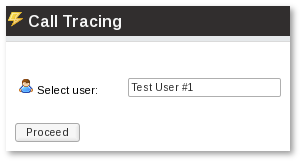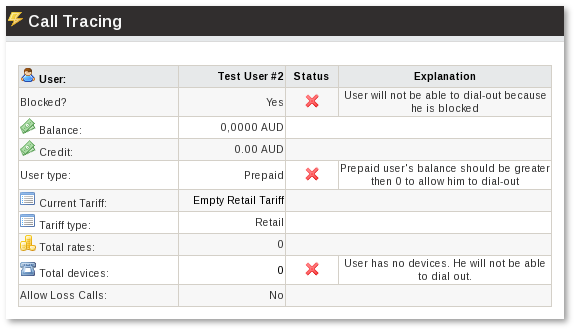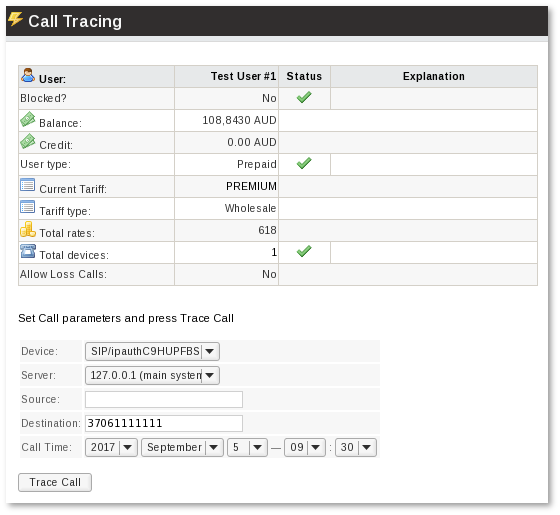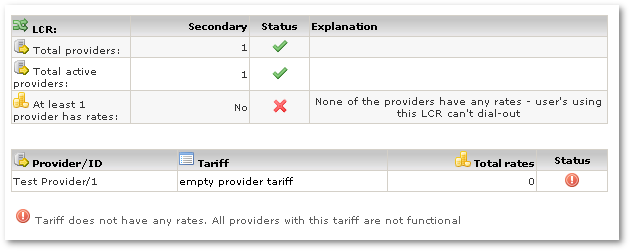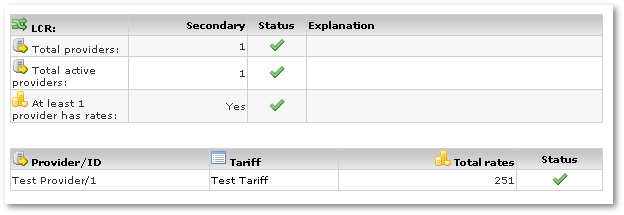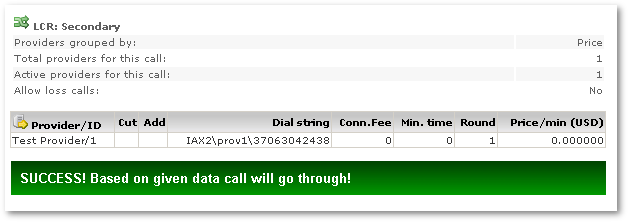Difference between revisions of "Call Tracing"
| Line 48: | Line 48: | ||
We can proceed with next section which is about LCR: | We can proceed with next section which is about [[LCR]]: | ||
[[Image:calltracing4.png]] | [[Image:calltracing4.png]] | ||
| Line 54: | Line 54: | ||
It tells us that LCR we assigned to the user has no Providers. We should fix it. When at least one Provider is in the LCR assigned to the User we should see: | It tells us that [[LCR]] we assigned to the user has no Providers. We should fix it. When at least one Provider is in the [[LCR]] assigned to the User we should see: | ||
[[Image:calltracing5.png]] | [[Image:calltracing5.png]] | ||
Revision as of 06:25, 18 February 2010
Overview
This function is for checking the setup of MOR in order to be sure user will be able to dial out. To setup MOR is not so trivial (we are trying to change this with this manual and GUI improvements). It often happens for users to miss some important detail trying to make everything work. Now Call Tracing will save a lot of head-scratching and we hope will help for a lot of beginners.
Important! This function is for testing Dialing OUT. DID testing is not implemented yet.
This function can be found in SETTINGS – Billing – Function – Call Tracing. It can be quickly accessed in Users menu (SETTINGS – Users) also. Just press ![]() icon for some user.
icon for some user.
In the first window we have to select which user we want to check:
User testing
Next window shows us did we configure everything properly for selected user. Let's look at each section separately.
The first one shows info special for user:
Here we see ![]() 4 errors which does not let user to operate. Let's say we want to make user to make calls. So we will go through each one of errors and fix them.
4 errors which does not let user to operate. Let's say we want to make user to make calls. So we will go through each one of errors and fix them.
1. This error tells us that user is Blocked and it will not be able to make calls. We should go to User Details and unblock him.
2. Balance and Credit for this user are empty. And user type is Prepaid. That means he has no funds to cover the call fees. There are several ways how to go about this:
- If user is postpaid – he should use some payment method to increase his balance. PayPal, Manual Payment and other ways are good to do this.
- We can change user type to postpaid and then we should adjust his credit. Maybe it is unlimited, maybe some limit exists. But that will allow user to dial out.
3. We see that user has assigned some tariff and type of tariff. Type of tariff is just for informational purposes. Here 'Explanation' tells us that tariff is empty. That is the reason why user will not be able to dial out. User can dial out only to these destinations which have rates. Currently none of them has. You need to put some rates to the existing tariff or assign non-empty tariff to this user.
4. User has no devices. Device is necessary to dial out. Just create one for this user.
After solving all these issues we should see:
We can proceed with next section which is about LCR:
It tells us that LCR we assigned to the user has no Providers. We should fix it. When at least one Provider is in the LCR assigned to the User we should see:
This error happens when all providers in LCR are disabled. We need to have at least 1 active provider in order for user to be able to dial-out:
Now none of our active providers has any rates. We should add rates to the provider's tariff. We can press directly on the Tariff to go to its rates and add some of them. After that we should see:
To summarize all this section you should check for ![]() and read error descriptions. After fixing them you should see
and read error descriptions. After fixing them you should see ![]() . That means problem is solved and you can proceed. If at the bottom of the page you see:
. That means problem is solved and you can proceed. If at the bottom of the page you see:
That means you still have unresolved issues. After all issues are solved you should see:
When you see this green message you know that your user is configured properly. He is not blocked, he has enough money in his balance to pay for the call, his tariff has some rates for some destinations (so only these destinations are available to dial), he has some devices to use for dialing. Also his LCR has active providers with not empty tariffs.
You can proceed.
Device testing
Following section let's us choose device, call date and enter destination which we want to test. For example:
This data means that we are testing virtual call from device SIP/1004 to number 863042438 on 2009 August 26th 00:00.
When we press Press this button to continue we will go to the next page and we will see something like:
Details section shows us just informational info. We knew this info before so it is not important.
If you see direction as Unknown that means your number is not in E.164 compatible format. Edit Localization rules to transform your number to E.164 number format.
Localization section is much more important.
Here we see device's Location, Applied rule and result after localization.
IMPORTANT! Software can't read user's mind so it can't know where user is dialing.
This can be illustrated by this example:
User dials 863042438. After Localization we see that number is still: 863042438. Which means it's somewhere in China. But it's wrong because user dialed Lithuanian number in local format! What does it mean? It means that Localization is not configured properly. MOR can't show you error here because there's no way to tell if it's ok or not.
You should decide for yourself. What MOR can do – just to show you all info it can get from the call and it does that.
So in order to proceed with example we have to set correct Localization rule for this number format. After doing this we will see:
Now everything is ok. Localized destination is E.164 compatible. Now MOR understands that it's Lithuania as it should be.
If we get following window:
That means we do not have rates or custom rates for dialed destination. After adding them we should see:
This window also shows us that we do not have custom rate for this destination. But it's enough to have simple rate for destination to be able to dial out or vice versa.
We can proceed to the providers:
We can see that our provider does not have rate for this destination. After fixing it we should see:
That's it. Now real call should go out without problems.
Conclusion
To summarize Call Tracing – it is very important to configure Localization properly.
You will see using Call Tracing what is happening and where the call is going.
When rates for user and provider are checked using localized destination. When all data are in place – there's no obstacle for call to be send to provider.
IMPORTANT! Green message at the end of Call Tracing does not mean call will be successful! It only means that MOR will send call to provider. What string it will send to provider you can see in last table. Applied Provider Rule parameters (Cut and Add) are also visible in the table. MOR can't know if provider accepts your dial string or not.
That depends how you configured Provider Rules. Call Tracing shows you formatted number which is sent to provider but you should decide is it correct or not.
If call fails - check Users Calls or Providers Calls and check Hangupcause Codes to find a reason why call failed.
